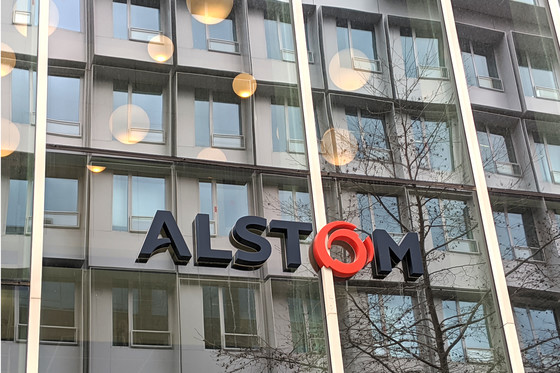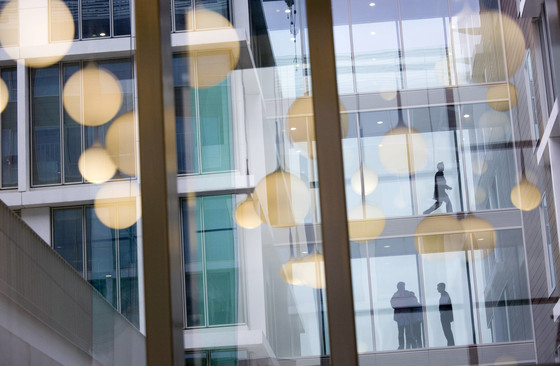
Alstom’s orders and sales for the first three months of 2022/23
-
Q1 order intake at €5.6 billion, including large orders in Rolling Stock bundled with Services
-
Sustained backlog at €83.4 billion
-
Solid Q1 sales at €4.0 billion, up 8%[1] vs. last year, in line with announced growth trajectory
-
Full year outlook and mid-term 2024/25 objectives confirmed
19 July 2022 – Over the first quarter of 2022/23 (from 1 April to 30 June 2022), Alstom booked €5.6 billion of orders. The Group sales increased by 8% reaching €4.0 billion, in line with the targeted trajectory. The backlog, as of 30 June 2022, settled at €83.4 billion, providing strong visibility on future sales.
Key figures
|
Actual figures (in € million) |
2021/22 Q1
|
2022/23 Q1 |
% Change Reported |
% Change Organic |
|
Orders received |
6,439 |
5,601 |
(13)% |
(16)% |
|
Sales |
3,701 |
4,002 |
+8% |
+5% |
Geographic and product breakdowns of reported orders and sales are provided in Appendix 1. All figures mentioned in this release are unaudited.
“Alstom has recorded a solid quarterly order intake on the back of a continuously sound market. In particular, the Group secured a landmark contract to supply 130 Coradia Stream trains with 30 years of maintenance for the state of Baden-Württemberg, demonstrating our leadership in Germany. Our sales have developed as expected, thanks to the stabilisation of our Rolling Stock projects and strong performance in Services and Systems. Despite a more complex global environment, marked notably by inflation and the electronic components shortages, the Group continues to progress on the delivery of its Alstom in Motion strategic plan, demonstrating the resilience of its business model,” said Henri Poupart-Lafarge, Alstom Chairman and Chief Executive Officer.
***
Detailed review
During the first quarter of 2022/23 (from 1 April to 30 June 2022), Alstom recorded €5,601 million in orders, with notably strong order intake in Rolling Stock and Services. Orders for Services reached a new record level of €1,844 million. Over three months, orders for Services, Signalling and Systems reached 46% of the total order intake.
On a regional level, Europe accounted for the majority of the orders, i.e. 70% of the Group total. Of particular note, Alstom was awarded a landmark contract to supply 130 Coradia Stream High Capacity electric double-deck trains, together with full maintenance for 30 years, to Landesanstalt Schienenfahrzeuge Baden-Württemberg (SFBW) network in Germany. Furthermore, the contract reserves an option to order up to 100 additional trains. With a value of almost €2.5 billion for the first 130 trains and 30 years’ maintenance, this order is a positive indication for Alstom’s market share ambitions in Germany.
Alstom also signed an historic agreement with Sweden’s national rail operator SJ to supply 25 Zefiro Express electric high-speed trains, with an option of 15 additional trains. The contract for the firm tranche is valued at around €650 million. The new trains will be Sweden’s fastest, capable of operating at maximum speeds of 250km/h. The first train is scheduled for delivery in 2026.
In the Asia/Pacific region, Alstom has signed a framework contract with the Department of Transport of Victoria in Australia, for the provision of 100 Flexity low-floor Next Generation Trams (NGTs) for the largest urban tram network in the world. Valued at approximately €700 million, the contract includes supply of rolling stock and 15 years of maintenance, making this the biggest tram contract in Australia and in the Southern hemisphere.
Sales were €4,002 million in Q1 2022/23 (from 1 April to 30 June 2022) versus €3,701 million in Q1 2021/22 (+8%). In Systems, Alstom reported €388 million sales, up 63% vs. last year, including remarkable growth on the Cairo monorail project. Services delivered €909 million of sales in Q1 2022/23, up 19% versus last year, demonstrating a sound level of execution. Sales in Rolling Stock stood at €2,175 million, up 1% versus last year, reflecting stronger contributions from projects in India and in the UK, which are ramping-up, and contracts in Switzerland and Canada ramping-down. Signalling sales stood at €530 million in Q1 2022/23, roughly stable versus Q1 2021/22.
The book-to-bill ratio is 1.4.
***
Main highlights of the first quarter of 2022/23
During the quarter, Alstom reached important delivery milestones, and launched a range of initiatives to accelerate its transformation into a more competitive and agile group.
1. Key projects achievements
In May, the new Elizabeth line entered passenger service under Central London using Alstom’s state-of-the-art Aventra fleet. Alstom has supplied trains, technology and infrastructure for this new line and will also maintain the trains. The transformational railway is set to reduce journey times, to create additional transport capacity, to improve accessibility and to provide an economic boost to the capital and beyond.
Also in May, Alstom successfully delivered India’s first semi high-speed regional train for Delhi-Meerut RRTS project. The first train has been delivered in less than a year since the beginning of production, and is 100% made in India at Alstom’s factory in Savli (Gujarat). The semi high-speed regional train is designed and built to run at 180 km/h, and is expected to decrease travel time between Delhi-Meerut by 40%. These trains are energy efficient, designed to offer high end comfort and safety features for premium passenger experience for commuters, including those who are disabled.
2. Smart and green mobility
In April, Alstom took another step towards Autonomous Train Operation by testing Elta Systems Obstacle Detection System (ODS) with infrastructure manager ProRail and rail freight operator Lineas in the Netherlands. These tests, which were conducted in Oosterhout, near the city of Breda in the Netherlands, have demonstrated that the ODS installed aboard the locomotive is able to detect obstacles up to 500 metres ahead in all weather and visibility (day and night) conditions. It can be operated as a Driver Assistance System, as well as a fully automated system in conjunction with Alstom’s AutoPilot component. The next steps, to be finalised this summer, will be to test ODS in combination with Automatic Train Operation (ATO) to pave the way for GoA4[1] in freight.
At the end of May, Alstom signed a strategic cooperation agreement with PKN ORLEN for the supply of zero-emission, eco-friendly trains and hydrogen fuel for public rail transport. The corporation, which is implementing the hydrogen strategy, announced earlier this year that it will provide the refuelling infrastructure for trains produced by Alstom. Under the agreement, Alstom will be responsible for the supply of zero-emission trains powered by hydrogen fuel cells.
3. One Alstom team Agile, Inclusive and Responsible
In May 2022, the Group disclosed its enhanced ESG 2025 targets applicable to the whole new perimeter as well as its commitment to achieving Net Zero carbon in its value chain by 2050. CO2 emissions targets have been set for 2030 covering Alstom’s own direct and indirect emissions (scope 1 & 2) as well as indirect emissions from Products sold (Scope 3). Alstom plans to further engage with suppliers and customers to make its solutions Net Zero through their entire life cycle[2].
The reinforced strategy reflects the Group’s commitment to deliver a strong response to increased expectations on sustainability performance from stakeholders. Its priorities remain: Enabling decarbonisation of mobility; Caring for our people; Creating a positive impact on society; and Acting as a responsible business partner.
As part of its Sustainability strategy, Alstom published in June its CSR journey brochure, now available on our website.
***
Financial trajectory for FY 2022/23
The current economic and political context, becoming more complex, creates uncertainties in business activities, and Alstom is no exception. In particular, inflation is expected to weigh to some extent on FY 2022/23 profitability, and the electronic components shortages may create tension on the deliveries. The Group has therefore put in place strong risk mitigation and cost-out actions to navigate these uncertainties.
As the basis for its 2022/23 outlook, the Group assumes neither further disruptions to the world economy (including further inflation or aggravated geopolitical crisis), nor significant supply-chain shortages, that would materially impact the Group’s ability to deliver products and services.
- Sales growth supported by solid order backlog and Book to bill ratio above 1
- Progressive aEBIT margin increase vs FY 2021/22 through healthy order intake and sound backlog execution
- Free Cash Flow generation[3]
***
Mid-term financial trajectory and objectives
The outlook given in connection with Alstom in Motion 2025 is confirmed.
- Market share: By 2024/25, Alstom is aiming to grow its market share by 5 percentage points[4] by leveraging its unique strategic positioning, supported by its enlarged group momentum and its competitive offering.
- Sales: Between 2020/21 (proforma sales of €14 billion) – and 2024/25, Alstom is aiming at sales Compound Annual Growth Rate over 5% supported by strong market momentum and unparalleled €83.4 billion backlog as of 30 June 2022, securing sales of ca. €35 to 37 billion over the next three years. Rolling stock should grow above market rate, Services at solid mid-single digit path and Signalling at high single digit path.
- Profitability: The adjusted EBIT margin should reach between 8% and 10% from 2024/25 onwards, benefiting from operational excellence initiatives, the completion of the challenging projects in backlog while synergies are expected to deliver €400 million run rate in 2024/25 and €475 - 500 million annually from 2025/26 onwards.
- Free Cash Flow: from 2024/25 onwards, the conversion from adjusted net profit[5] to Free Cash Flow should be over 80%[6] driven by mid-term stability of working capital, stabilisation of CAPEX to around 2% of sales and cash focus initiatives while benefiting from volume and synergies take up.
- Alstom will maintain its disciplined capital allocation focusing on maintaining its investment grade profile, while keeping flexibility and ability to pursue growth opportunities through focused bolt-on M&A. Alstom’s Baa2 rating with negative outlook was confirmed during Q1 by Moody’s.
- Alstom is committed to delivering sustained shareholder returns with a dividend pay-out ratio[7] of between 25% and 35%.[8]
***
Combined Shareholders’ Meeting
The Combined Shareholders’ Meeting of Alstom was held on July 12, 2022, under the chairmanship of Mr. Henri Poupart-Lafarge. The Shareholders’ Meeting was the opportunity to review the highlights of the fiscal year 2021/22 as well as the first year of integration of Bombardier Transportation. The Combined Shareholders’ Meeting approved the dividend related to the 2021/22 fiscal year for an amount of €0.25 gross per share, and has decided to offer to each shareholder an option, with respect to 100% of the dividends attached to the shares owned by such shareholder, for payment of such dividend to be made in cash or in new shares.
The shareholders adopted all the resolutions approved by the Board of Directors.
The full results of the votes as well as the presentations made to shareholders will be available on July 20, 2022, on the Alstom website.
This press release contains forward-looking statements which are based on current plans and forecasts of Alstom’s management. Such forward-looking statements are relevant to the current scope of activity and are by their nature subject to a number of important risks and uncertainty factors (such as those described in the documents filed by Alstom with the French AMF) that could cause actual results to differ from the plans, objectives and expectations expressed in such forward-looking statements. These such forward-looking statements speak only as of the date on which they are made, and Alstom undertakes no obligation to update or revise any of them, whether as a result of new information, future events or otherwise.
This press release does not constitute or form part of a prospectus or any offer or invitation for the sale or issue of, or any offer or inducement to purchase or subscribe for, or any solicitation of any offer to purchase or subscribe for any shares or other securities in the Company in France, the United Kingdom, the United States or any other jurisdiction. Any offer of the Company’s securities may only be made in France pursuant to a prospectus having received the visa from the AMF or, outside France, pursuant to an offering document prepared for such purpose. The information does not constitute any form of commitment on the part of the Company or any other person. Neither the information nor any other written or oral information made available to any recipient or its advisers will form the basis of any contract or commitment whatsoever. In particular, in furnishing the information, the Company, the Banks, their affiliates, shareholders, and their respective directors, officers, advisers, employees or representatives undertake no obligation to provide the recipient with access to any additional information.
APPENDIX 1A – GEOGRAPHIC BREAKDOWN
|
Actual figures |
2021/22 |
% |
2022/23 |
% |
|
(in € million) |
3 months |
Contrib. |
3 months |
Contrib. |
|
Europe |
4,559 |
71% |
3,933 |
70% |
|
Americas |
1,696 |
26% |
405 |
7% |
|
Asia / Pacific |
50 |
1% |
1,235 |
22% |
|
Middle East / Africa |
134 |
2% |
28 |
1% |
|
Orders by destination |
6,439 |
100% |
5,601 |
100% |
|
Actual figures |
2021/22 |
% |
2022/23 |
% |
|
(in € million) |
3 months |
Contrib. |
3 months |
Contrib. |
|
Europe |
2,323 |
63% |
2,412 |
60% |
|
Americas |
648 |
17% |
661 |
17% |
|
Asia / Pacific |
467 |
13% |
574 |
14% |
|
Middle East / Africa |
263 |
7% |
355 |
9% |
|
Sales by destination |
3,701 |
100% |
4,002 |
100% |
APPENDIX 1B – PRODUCT BREAKDOWN
|
Actual figures |
2021/22 |
% |
2022/23 |
% |
|
(in € million) |
3 months |
Contrib. |
3 months |
Contrib. |
|
Rolling stock |
3,362 |
52% |
3,013 |
54% |
|
Services |
1,139 |
18% |
1,844 |
33% |
|
Systems |
1,366 |
21% |
271 |
5% |
|
Signalling |
572 |
9% |
473 |
8% |
|
Orders by product line |
6,439 |
100% |
5,601 |
100% |
|
Actual figures |
2021/22 |
% |
2022/23 |
% |
|
(in € million) |
3 months |
Contrib. |
3 months |
Contrib. |
|
Rolling stock |
2,164 |
58% |
2,175 |
54% |
|
Services |
762 |
21% |
909 |
23% |
|
Systems |
238 |
6% |
388 |
10% |
|
Signalling |
537 |
15% |
530 |
13% |
|
Sales by product line |
3,701 |
100% |
4,002 |
100% |
APPENDIX 2 - NON-GAAP FINANCIAL INDICATORS DEFINITIONS
This section presents financial indicators used by the Group that are not defined by accounting standard setters.
Orders received
A new order is recognised as an order received only when the contract creates enforceable obligations between the Group and its customer. When this condition is met, the order is recognised at the contract value. If the contract is denominated in a currency other than the functional currency of the reporting unit, the Group requires the immediate elimination of currency exposure using forward currency sales. Orders are then measured using the spot rate at inception of hedging instruments.
Book-to-Bill
The book-to-bill ratio is the ratio of orders received to the amount of sales traded for a specific period.
Adjusted EBIT
Adjusted EBIT (“aEBIT”) is the Key Performance Indicator to present the level of recurring operational performance. This indicator is also aligned with market practice and comparable to direct competitors.
Starting September 2019, Alstom has opted for the inclusion of the share in net income of the equity-accounted investments into the aEBIT when these are considered to be part of the operating activities of the Group (because there are significant operational flows and/or common project execution with these entities). This mainly includes Chinese joint-ventures, namely CASCO joint-venture for Alstom as well as, following the integration of Bombardier Transportation, Alstom Sifang (Qingdao) Transportation Ltd. (former Bombardier Sifang), Bombardier NUG Propulsion System Co. Ltd. and Changchun Changke Alstom Railway Vehicles Company Ltd (former Changchun Bombardier).
aEBIT corresponds to Earning Before Interests and Tax adjusted for the following elements:
- net restructuring expenses (including rationalization costs)
- tangibles and intangibles impairement
- capital gains or loss/revaluation on investments disposals or controls changes of an entity
- any other non-recurring items, such as some costs incurred to realize business combinations and amortization of an asset exclusively valued in the context of business combination, as well as litigation costs that have arisen outside the ordinary course of business
- and including the share in net income of the operational equity-accounted investments
A non-recurring item is a “one-off” exceptional item that is not supposed to occur again in following years and that is significant.
Adjusted EBIT margin corresponds to Adjusted EBIT expressed as a percentage of sales.
Adjusted net profit
Following the Bombardier Transportation, Alstom decided to introduce the “adjusted net profit” indicator aimed at restating its net profit from continued operations (Group share) to exclude the impact of amortisation of assets exclusively valued when determining the purchase price allocations (“PPA”) in the context of business combination, net of the corresponding tax effect. This indicator is also aligned with market practice.
Free cash flow
Free Cash Flow is defined as net cash provided by operating activities minus capital expenditures including capitalised development costs, net of proceeds from disposals of tangible and intangible assets. Free Cash Flow does not include any proceeds from disposals of activity.
The most directly comparable financial measure to Free Cash Flow calculated and presented in accordance with IFRS is net cash provided by operating activities.
Net cash/(debt)
The net cash/(debt) is defined as cash and cash equivalents, marketable securities and other current financial asset, less borrowings.
Pay-out ratio
The pay-out ratio is calculated by dividing the amount of the overall dividend with the “Adjusted Net profit from continuing operations attributable to equity holders of the parent, Group share” as presented in the management report in the consolidated financial statements.
Organic basis
Figures given on an organic basis eliminate the impact of changes in scope of consolidation and changes resulting from the translation of the accounts into Euro following the variation of foreign currencies against the Euro. The Group uses figures prepared on an organic basis both for internal analysis and for external communication, as it believes they provide means to analyse and explain variations from one period to another. However, these figures are not measurements of performance under IFRS.
|
|
Q1 2021/22 |
|
Q1 2022/23 |
|
|
|
||
|
(in € million) |
Actual |
Exchange |
Comparable |
Actual |
% Var Act. |
% Var Org. |
||
|
Orders |
6,439 |
225 |
6,664 |
|
5,601 |
|
(13)% |
(16)% |
|
Sales |
3,701 |
123 |
3,824 |
|
4,002 |
|
8% |
5% |
[1] Of which 5% organic growth.
[2] Grade of Automation 4
[3] Reduction of GHG emissions (Scope 1 et 2) from Alstom’s sites by 40% by 2030 compared to FY2021/22. Reduction of GHG emissions (Scope 3) from the use of sold rolling stock products by 35% per passenger-km and per tonne-km by 2030 compared to FY2021/22.
[4] Subject to short term volatility
[5] In comparison to Alstom’s market share in 2020/21
[6] Adjusted net profit
[7] Subject to short term volatility
[8] The pay-out ratio is calculated by dividing the amount of the overall dividend with the “Adjusted net profit from continuing operations attributable to equity holders of the parent, Group share” as presented in the management report in the consolidated financial statements.
[9] Of adjusted net profit


